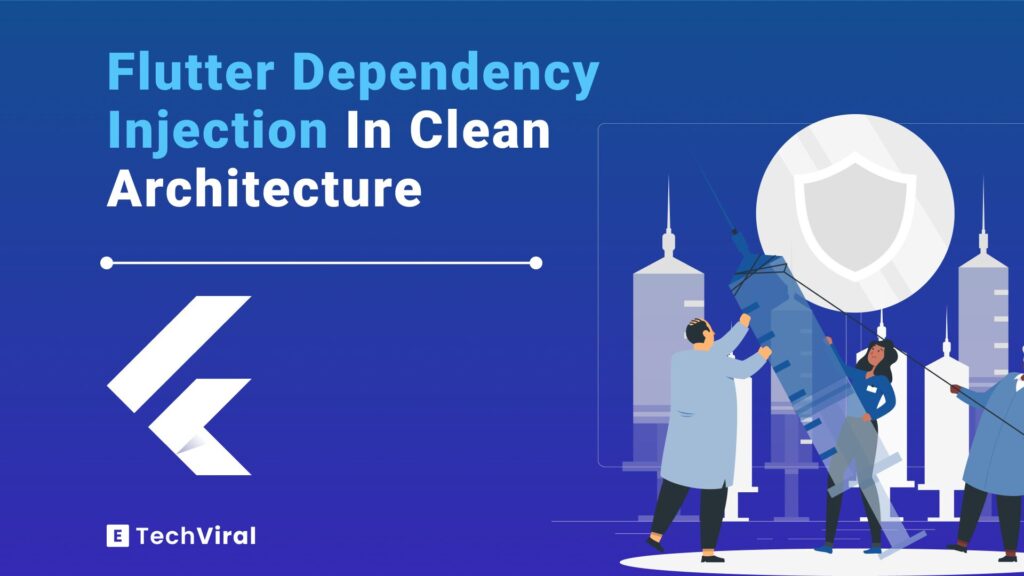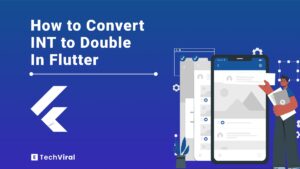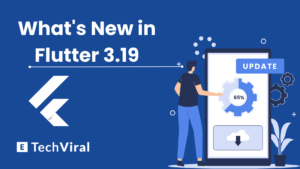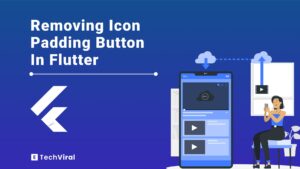Dependency injection in Flutter clean architecture plays a crucial role, in this guide, we will explore how dependency injection (DI) beautifully fits into Flutter’s Clean Architecture.
Whether you’re new or seasoned in Flutter, this guide will deepen your understanding and skills.
And you will understand how to implement dependency injection in flutter projects practically.
Key takeaways:
- You’ll learn the fundamentals of DI in the context of Flutter’s Clean Architecture.
- Learn practical implementation techniques of DI in Flutter.
- Explore various DI frameworks suitable for Flutter and how to choose the best one.
- Understand advanced DI patterns for large-scale Flutter projects.
- Gain insights from real-world case studies on effectively implementing DI in Flutter.
- Equip yourself with knowledge for future trends in Flutter development with a focus on Dependency Injection.
Understanding Dependency Injection in Flutter’s Context
Dependency Injection (DI) is a design pattern crucial for efficient and effective Flutter app development. It involves supplying objects (dependencies) to a class, rather than having the class create these objects directly.
This approach is particularly important in Flutter’s Clean Architecture, where it fosters a decoupled, testable, and maintainable code structure.
Core Principles of Dependency Injection in Flutter Clean Architecture
In the Clean Architecture framework for Flutter, DI plays a pivotal role in separating concerns across different layers of the application.
Here are the key principles:
- DI helps in clearly dividing the app’s functionalities into distinct layers – Presentation, Business Logic, and Data.
- By isolating dependencies, DI allows for easier unit testing, especially in the Business Logic Layer, where the core functionality resides.
- DI promotes the reusability of code and eases the maintenance process by centralizing the creation and distribution of dependencies.
Dependency Injections Impact on Flutter’s Architectural Layers
Each layer in Flutter’s Clean Architecture has unique DI requirements:
Presentation Layer: Dependencies here typically include view models and services that provide data. DI ensures these dependencies are modular and interchangeable.
Business Logic Layer: This layer benefits significantly from DI, as it allows business logic components to be independent of external data sources.
Data Layer: DI in the data layer aids in abstracting the data sources, making the app adaptable to changes in data storage or retrieval mechanisms.
Implementing DI in Flutter Using Clean Architecture
Setting Up Clean Architecture in Flutter
To effectively implement Dependency Injection in Flutter, it’s essential first to set up the Clean Architecture framework. This structure divides your project into three main layers: Presentation, Business Logic, and Data.
- Start by organizing your Flutter project into separate directories for each layer – presentation, domain, and data.
- Ensure each layer has a clear responsibility. The presentation layer handles UI, the domain layer manages business logic, and the data layer deals with data sources and repositories.
Integrating Dependency Injection in Each Layer
Presentation Layer
- Use Case: Inject view models or controllers that connect UI components with business logic.
Example:
class MyHomePage extends StatelessWidget {
final UserViewModel userViewModel;
MyHomePage({Key key, this.userViewModel}) : super(key: key);
@override
Widget build(BuildContext context) {
// Use userViewModel here
}
}
- DI Tool: Utilize a framework like Provider to supply the view model to the UI components.
Business Logic Layer
- Use Case: Inject repositories or use cases into business logic entities.
Example:
class UserUseCase {
final UserRepository userRepository;
UserUseCase(this.userRepository);
Future<User> getUserDetails() async {
return await userRepository.fetchUser();
}
}
- DI Tool: Leverage GetIt or similar for injecting repositories into use cases.
Data Layer
- Use Case: Inject data sources into repositories.
Example:
class UserRepository {
final UserDataSource userDataSource;
UserRepository(this.userDataSource);
Future<User> fetchUser() async {
return await userDataSource.getUser();
}
}
- DI Tool: Again, GetIt can be used here for injecting data sources into repositories.
Working with DI Frameworks in Flutter
Frameworks like Provider and GetIt simplify the DI process in Flutter.
Provider
- Usage: Wrap your app with Provider or MultiProvider and supply the necessary dependencies.
Example:
void main() {
runApp(
Provider<UserViewModel>(
create: (_) => UserViewModel(),
child: MyApp(),
),
);
}
GetIt
- Setup: Initialize GetIt and register your dependencies.
Example:
final getIt = GetIt.instance;
void setupLocator() {
getIt.registerLazySingleton<UserRepository>(() => UserRepository());
}
void main() {
setupLocator();
runApp(MyApp());
}
Tools and Frameworks for DI in Flutter
Exploring DI Frameworks Compatible with Flutter’s Clean Architecture
Dependency Injection (DI) in Flutter can be significantly streamlined using various frameworks and tools. These frameworks facilitate the DI process, making it more manageable and efficient, especially when adhering to Clean Architecture principles.
Let’s explore some of the popular DI frameworks and their use cases in Flutter.
Provider
- Overview: Provider is a widely-used DI framework in the Flutter community. It offers a simple way to manage state and dependencies.
- Usage in Clean Architecture: The use of clean architecture with Provider is excellent for injecting dependencies at the UI level. It’s commonly used to supply view models or controllers to widgets.
Example:
class MyApp extends StatelessWidget {
@override
Widget build(BuildContext context) {
return ChangeNotifierProvider(
create: (context) => UserViewModel(),
child: MaterialApp(
home: UserScreen(),
),
);
}
}
- GetIt
- Overview: GetIt is a service locator for Dart and Flutter, enabling developers to access objects from anywhere in the app.
- Usage in Clean Architecture: GetIt is ideal for managing dependencies in the business logic and data layers, allowing for more decoupled code.
Example:
final getIt = GetIt.instance;
void setup() {
getIt.registerSingleton<UserRepository>(UserRepositoryImpl());
}
class UserUseCase {
UserRepository get userRepository => getIt<UserRepository>();
// Use userRepository in business logic
}
Riverpod
- Overview: Riverpod is a newer DI framework that addresses some limitations of Provider, offering more flexibility and testability.
- Usage in Clean Architecture: Clean architecture with riverpod allows for better control over the state and dependencies, making it suitable for complex apps.
Example:
final userRepositoryProvider = Provider((ref) => UserRepositoryImpl());
class UserNotifier extends StateNotifier<UserState> {
UserNotifier(this.ref) : super(UserInitial());
final ProviderReference ref;
Future<void> fetchUser() async {
final userRepository = ref.read(userRepositoryProvider);
// Fetch user using userRepository
}
}
Choosing the Right DI Tool for Your Flutter Project
When selecting a DI framework for your Flutter project, consider the following factors:
- Project Size and Complexity: Larger projects might benefit from more robust frameworks like GetIt or Riverpod.
- Familiarity and Community Support: If you’re more comfortable with Provider and there’s ample community support for it, it might be the right choice for simpler applications.
- Testability and Flexibility: Frameworks like Riverpod offer enhanced testability and flexibility, which can be crucial for complex apps with dynamic requirements.
Advanced DI Strategies in Flutter’s Clean Architecture
Complex DI Patterns for Scalable Flutter Applications
As Flutter applications grow in size and complexity, advanced DI strategies become essential. These strategies ensure that the app remains scalable, maintainable, and testable.
Lazy Loading of Dependencies
- Concept: Only create an instance of a dependency when it’s needed.
- Implementation: Use lazySingleton in GetIt or ProxyProvider in Provider for lazy loading.
- Benefit: Reduces initial load time and memory usage, especially useful in large applications.
Scoped DI
- Concept: Limit the availability of certain dependencies to specific parts of the app.
- Implementation: Riverpod’s ProviderScope or Provider’s ChangeNotifierProvider can be used for scoping dependencies.
- Benefit: Increases control over how and where dependencies are used, enhancing security and performance.
Dependency Injection with Asynchronous Operations:
- Concept: Inject dependencies that require asynchronous initialization.
- Implementation: Use FutureProvider in Riverpod or asynchronous factory constructors in GetIt.
- Benefit: Seamlessly integrate asynchronous dependencies, crucial for operations like network requests or database initialization.
Optimizing Performance and Maintainability with Advanced DI Techniques
DI in Modular Flutter Architecture
- Approach: Break down the application into modules, each with its own DI setup.
- Example: Implementing feature-specific modules like auth_module, user_module, etc., each with their DI container.
- Advantage: Enhances modularity and makes the codebase more manageable and testable.
Integrating DI with State Management
- Strategy: Combine DI with state management solutions like BLoC or Redux for streamlined state handling.
- Example: Injecting a BLoC using DI tools and utilizing it for state management across the app.
- Advantage: Creates a more cohesive architecture, aligning state management with DI practices.
Automated Dependency Management
- Tool: Code generation tools like build_runner can be used to automate parts of the DI process.
- Advantage: Reduces boilerplate and potential human errors, especially in large projects with numerous dependencies.
Case Studies and Real-World Examples
Analyzing Successful Flutter Projects Utilizing DI in Clean Architecture
Real-world case studies are invaluable for understanding how Dependency Injection (DI) in Clean Architecture can be effectively implemented in Flutter applications. These examples highlight best practices and innovative approaches, providing practical insights.
E-Commerce App Case Study
- Overview: A Flutter-based e-commerce application implementing DI for dynamic product listing and user management.
- DI Implementation: Utilized Provider for UI-level dependencies and GetIt for business logic and data layers, ensuring a clean separation of concerns.
- Outcome: Enhanced modularity, easier maintenance, and improved performance during high-traffic periods.
Social Media Application Case Study
- Overview: A social media app with complex user interactions and real-time data updates.
- DI Implementation: Riverpod was chosen for its advanced state management and DI capabilities, handling the diverse needs of real-time chat, notifications, and content feeds.
- Outcome: Achieved a highly responsive and stable user experience, with streamlined development and testing processes.
Lessons Learned from Implementing DI in Flutter’s Clean Architecture
The Importance of Proper Planning
- Insight: Early planning of the DI strategy aligned with app architecture can prevent significant refactoring later.
- Takeaway: Invest time in designing the DI setup in line with the overall architecture from the project’s outset.
Flexibility and Scalability are Key
- Insight: Successful implementations often involve flexible DI patterns that accommodate growing and changing requirements.
- Takeaway: Choose DI tools and patterns that offer scalability and adaptability for future enhancements.
Testing Should Not Be an Afterthought
- Insight: Easier testing is a major advantage of DI, but it requires deliberate integration into the development process.
- Takeaway: Incorporate testing early in the development cycle, leveraging DI to mock and isolate dependencies.
Conclusion
Embracing Dependency Injection in Flutter Clean Architecture might seem daunting at first, but its benefits are undeniable. As you continue to explore and implement DI in your Flutter projects, remember that the journey is one of continuous learning and adaptation. The skills and principles you’ve gained from this guide will not only enhance your current projects but will also be invaluable assets in your future Flutter endeavors.
FAQ’s
How does dependency injection improve app performance in Flutter?
Dependency injection in Flutter significantly streamlines development by ensuring that objects are created and provided where needed, without unnecessary replication. This leads to more efficient memory use and quicker app performance, as dependencies are managed more effectively, resulting in smoother and faster execution of operations within the app’s clean architecture framework.
Can I use dependency injection with any state management solution in Flutter?
Yes, dependency injection in Flutter is versatile and can be integrated with various state management solutions. This flexibility allows developers to maintain a clean architecture while using their preferred state management approach, enhancing code modularity, maintainability, and the overall scalability of Flutter applications.
What are the common pitfalls when implementing dependency injection in Flutter?
Common pitfalls include overusing dependency injection, which can lead to unnecessarily complicated code, and improperly managing the lifecycle of injected objects, leading to memory leaks. Ensuring a clear understanding of when and where to use dependency injection is crucial for avoiding these issues and maintaining a clean and efficient architecture.
How does dependency injection facilitate testing in Flutter applications?
Dependency injection decouples the application’s components, making it easier to perform unit testing. By injecting mock dependencies during testing, developers can isolate and test individual components without relying on their external dependencies. This leads to more thorough and reliable tests, ensuring the application’s stability and performance.
Are there any tools or libraries recommended for implementing dependency injection in Flutter?
Several tools and libraries are available to facilitate dependency injection in Flutter, with GetIt and Provider being among the most popular. These libraries offer streamlined ways to implement dependency injection, enhancing code modularity and maintainability. Developers can choose the one that best fits their project needs and coding style.











